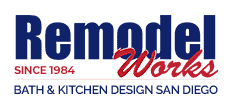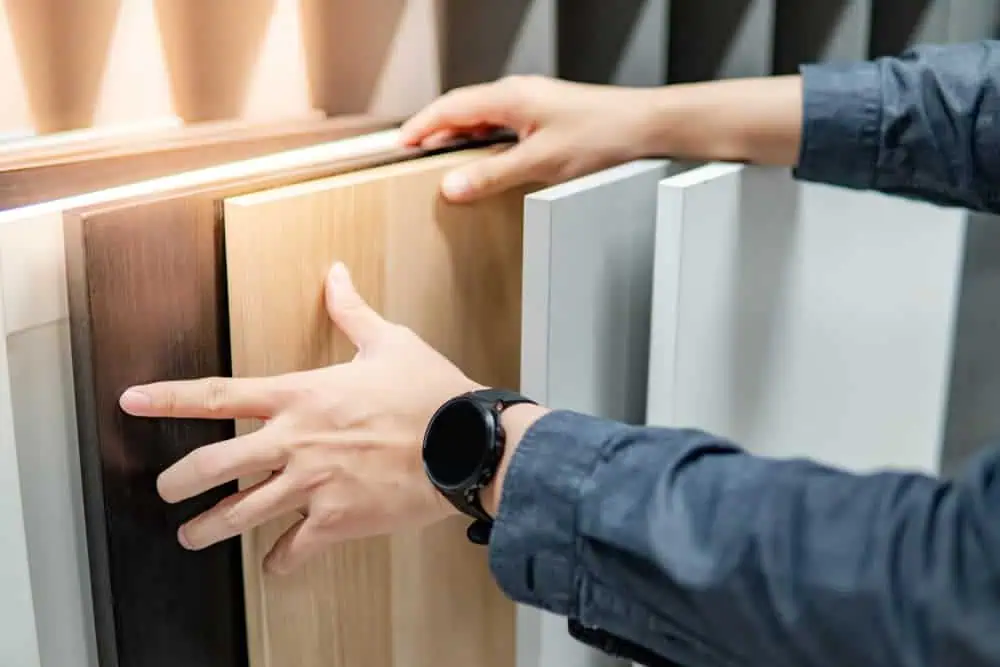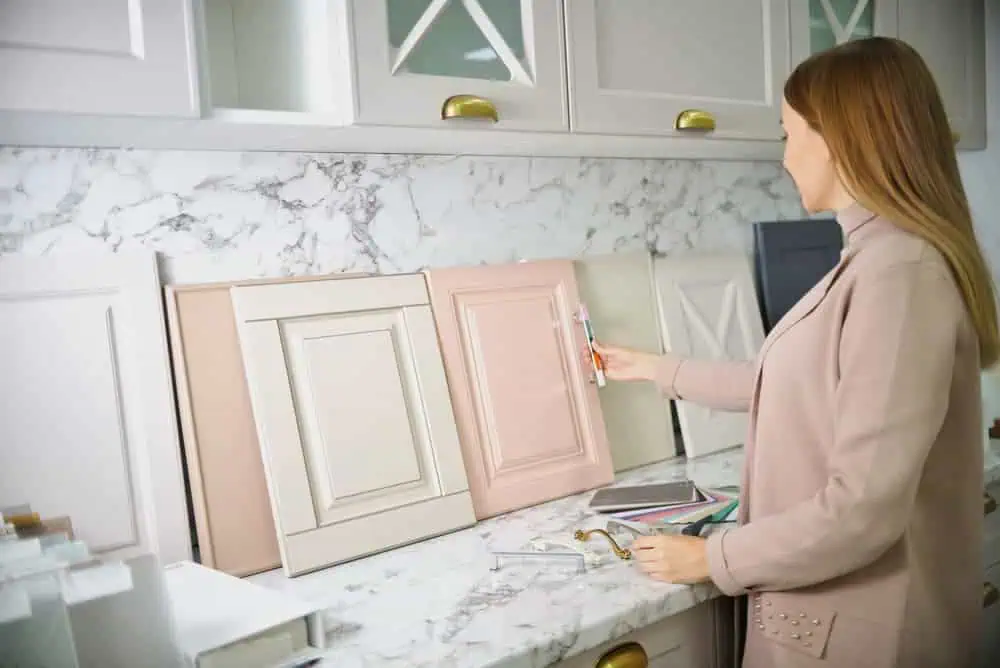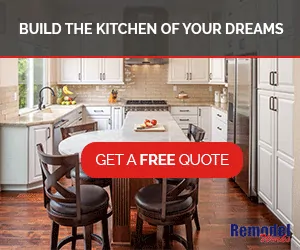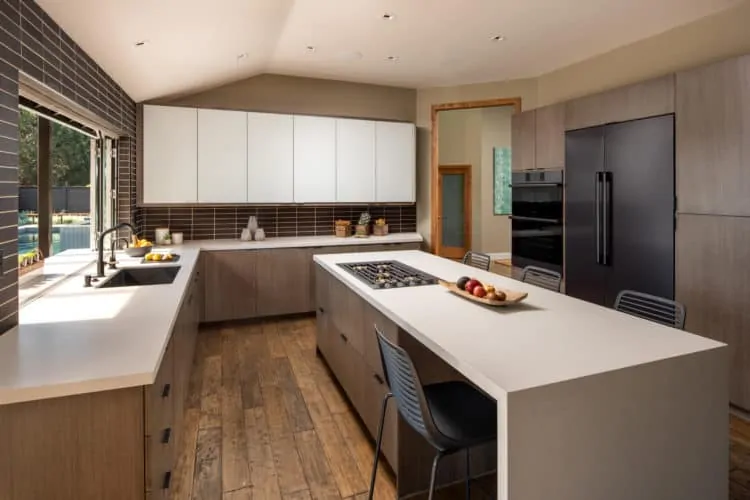
The Ultimate Guide To Cabinet Materials
If you’re kitchen remodeling in San Diego, then you know a part of it is deciding on what you will do about your cabinets. One choice stands out for its impact on the result: picking the best materials for your new kitchen cabinets.
It all depends on whether you want to refinish, reface, or completely replace your old cabinetry. If you choose one of the latter two, then the choice of material can make all the difference in how the final result looks, feels, and fits your needs. If you want to make sure that your final decision is fully informed, read on. We’ll explore some of the most popular materials below, and talk about the pros and cons of each!
What kind of wood is used for cabinets?
Usually, kitchen cabinets are made from wood and wood-based materials. The most popular of these materials include hardwood, plywood, medium-density fiberboard, particleboard, and wood veneer. Let’s dive into the details about each of them:
1. Hardwood
A material that has been in use since cabinets were invented decades ago, and that is still the most popular one out there is – hardwood. This is a natural element, harvested directly from trees, which means that each panel slightly varies in pattern from the next one. Here are some of their pros and cons:
Advantages
Here are some traits that make hardwood such a beloved choice for cabinets:
- It has a unique appeal and beauty, in part because each panel is naturally unique in pattern.
- Hardwood is exceptionally durable, so cabinets made from it have a long lifespan.
- It’s easy to repair, sometimes even by yourself – though it’s always best to leave the job to a professional. Even in case of scratches, stains, and watermarks, just addressing the problematic spot or refinishing your kitchen cabinets usually fixes the issue.
- There’s a wide range of wooden materials to choose from, each with its own distinct look, color, and feel. Some of the popular ones include white oak, red oak, hard maple, hickory, cherry, birch, ash, and pine.
Disadvantages
Despite the appeal and all its positive sides, hardwood does have some cons you should consider:
- Wood is generally one of the more expensive materials, and because hardwood is highly sought after, the prices can be even higher. For example, wood or wood combination cabinets start at about $80 per linear foot, and that price can easily double if you’re considering custom-made cabinets.
- Hardwood is generally heavy, so if you want to use it for all parts of your cabinets, you need to make sure that the structure can hold their weight.
- Not all types of wood are equally durable. Red oak may be very strong, for example, but something like pine can be pretty soft.
- Changes in humidity and temperature cause wood to contract and expand, which may result in warping.
If this material is your preferred choice but you’re worried about the price tag, an easy way to skirt the high cost of hardwood is by employing a mix of materials. Consider using hardwood for the face frames, doors, and drawer fronts, and medium-density fiberboard or wood veneer parts to strengthen the cabinets and lighten up the cost. Knowing these shortcuts can make your kitchen remodeling journey much easier.
2. Plywood
Another popular cabinet material, plywood offers a host of benefits. It is created by laminating thin layers of wood on top of each other through a mix of glue, heat, and pressure, in alternating directions of grain to make it stronger. Here’s what you need to know about plywood:
Advantages
Here are some benefits of this versatile material:
- Unlike hardwood, plywood resists moisture, it’s also flexible, durable, and easy to install. It’s considered to be the best option by many, if not for entire cabinets, then for sides, backs, shelves, and drawer bottoms.
- Due to its unique construction, plywood has the highest strength-to-weight ratio of all of the best cabinet materials. It is very strong and quite resilient.
- Plywood is easy to repair and replace, and it also withstands drilling better than many other materials. It’s basically a homeowner’s ideal cabinet material.
- In terms of affordability, plywood is highly accessible. It’s much less expensive than hardwood and costs more only when compared to lower-end materials.
Disadvantages
Despite the numerous benefits, there are some drawbacks of plywood that should be considered as well:
- You need to make sure you are using the right thickness of material for each area of the cabinets. Thinner plywood is typically used on cabinet backs, while thicker plywood is used on the sides and drawer bottoms.
- Plywood cabinets may lack consistency. There may be some gaps or holes where the boards were combined, which could make it more difficult to install plywood cabinets.
3. Particleboard
Also known as chipboard or low-density fiberboard (LDF), particleboard is another popular material usually brought up in comparison to plywood. This is an engineered wood product, and it’s made by pressing recycled products such as wood chips and sawmill shavings together to form them into sheets.
Since these sheets alone aren’t particularly good-looking or resilient, particleboard is usually sealed in with wood veneer or laminate for a nicer, better finish. Here are some things to consider:
Advantages
Here’s a summary of the major benefits of particleboard:
- Particleboard is one of the most affordable cabinet material types available for purchase. This is because particleboard is made with scrap materials. If we’re comparing the price of a higher-grade cabinet set made from plywood with medium-grade ones made from particleboard, the cost savings are usually between 10 and 20%.
- If you make sure you’re using a high-quality option, particleboard can be quite sturdy and durable.
- Particleboard is one of the best choices for cabinet and drawer interiors. It’s lightweight, cost-effective, and easy to fit into all the necessary spaces.
Disadvantages
Let’s now take a look at some potential drawbacks:
- Unless you find a very high-quality variation of it, particleboard is not very durable for the most part. Due to its construction, particleboard is generally weak under tension and compression.
- Particleboard is not moisture-friendly and can degrade and discolor if it comes into contact with water.
- If cabinets or drawers are overfilled, cabinet shelves and drawer bottoms made from particleboard can fall victim to sagging.
4. Medium-density fiberboard
If you need a material that falls somewhere between particleboard and plywood when it comes to quality, then medium-density fiberboard (MDF) may be right for you. This is a composite material made from recycled fibers, resin, and wax, pressed together and sealed in a high-pressure system.
MDF became popular due to mainstream IKEA cabinets that feature it, and the smaller size of its wood fibers makes it more resilient than particleboard. Here are some of the notable pros and cons of using it as a cabinet material:
Advantages
Here’s what you need to know about this popular material:
- This material is strong and durable because of its special composition and small fibers.
- MDF resists warping and expansion resulting from changes in moisture or temperature.
- Since the surface of medium-density fiberboard has a smooth finish, it handles painting and staining well.
- MDF offers superior screw-holding power and, as far as cabinet materials go, it’s fairly easy to manipulate.
Disadvantages
In addition to the advantages listed above, there are some drawbacks you should know about before opting for this material:
- MDF is not as strong as other cabinet materials, like plywood or hardwood. It is susceptible to sagging and damage if cabinets and drawers are overloaded.
- Some people have concerns about MDF due to its high formaldehyde emissions, the highest among pressed woods according to the National Kitchen and Bath Association. If you’re worried about materials used in your home, you’ll want to do some extra research before moving forward with this option.
5. Wood veneer
Another option for kitchen cabinet materials is wood veneer, which is a very thin layer of solid hardwood peeled from a log. This type of material has many similar benefits to hardwood, but since it is used in much smaller amounts, it has some other qualities that should be observed.
Another option for kitchen cabinet materials is wood veneer, a very thin layer of solid hardwood peeled from a log. These layers are usually thinner than 2mm and are most commonly used in tandem with other materials. Usually, they come glued and pressed to particle board or fiberboard. This material has many benefits similar to those of hardwood but, since it is used in much smaller amounts, it also comes with some differences. Let’s take a look at them:
Advantages
- Due to its unique structure of materials that feature it, wood veneer allows homeowners to reap the aesthetics and durability of hardwood, but with some additional perks.
- Since it is lightweight yet stable, wood veneer is preferred over other top finishes.
- Wood veneer is also an affordable variation of true hardwood.
Disadvantages
While there aren’t many true disadvantages of wood veneer, keep this in mind:
- Wood veneer is a finish material, so it shouldn’t be used for cabinet interiors (e.g. the box or frame), only for cabinet doors. You will have to choose another material option, such as plywood, particleboard, or MDF to construct the interior of the cabinets.
What are kitchen cabinets made of if not wood?
If you’re not sold on the materials listed above, or if you’d like to exhaust your list of options, here are a few other cabinet materials for you to consider.
1. Laminate
A highly affordable and versatile option, laminate continues to be a popular choice for various kitchen surfaces, from cabinets to countertops and even floors. But similar to wood veneer, laminate isn’t used for cabinetry shelves or drawers – it’s only a good option for kitchen cabinet doors, drawer faces, and only some interior surfaces.
Laminate used for cabinets is made of three layers: a paper base layer, a printed and colored layer, and a protective transparent layer. All of them are saturated with resin and fused together to create a durable cabinet face alternative.
Cabinets made from this material can be quite durable, especially if you opt for a higher-quality option. The price may be higher than that of low-grade options, but they also come with a lower tendency to crack, chip, and scuff.
2. Thermofoil
Another non-wood option for kitchen cabinet materials is thermofoil. Similar to laminate, this material involves a layer being applied to a substrate, in this case – vinyl film.
This material is preferred by many as it mimics the appearance of wood even better than laminate, and comes at an affordable price. Thermofoil finishes are usually white or light in color, which can give your updated kitchen a fresh look. They are durable, less prone to damage, and overall easy to take care of.
Both thermofoil and laminate are affordable options, with an average price of $50 – 75 per linear foot. If you’re on a budget, you have the option to choose particleboard or another affordable option for interiors and use one of these non-wood materials to finish the surfaces.
Final notes
As promised, this was a summary of the best and the most popular materials used for cabinetry. Before you choose your kitchen cabinets, take time to learn as much as you can about these materials. Weigh all options carefully, and see how each fits your budget, design, and functional needs, carefully think about whether you want custom cabinetry or some additional features or improvements.
Which company specializes in quality kitchen remodeling in San Diego?
If you’re looking to transform your kitchen with perfect new or updated cabinets, count on Remodel Works to make it happen. Whether you want to refresh the feel of your space, open up the kitchen to the dining room, or renovate another part of your home, we can make your vision a reality.
Our dedicated professionals have the knowledge and experience to tailor any project to your specific needs and deliver results that exceed your expectations. From downtown San Diego to the farthest corners of the city and beyond, we serve the entire metro area and can help wherever you are. Contact us today to start your dream remodel!
